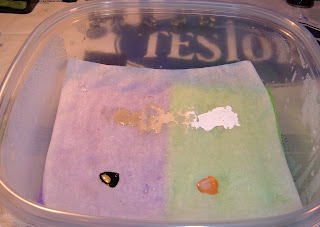What you'll need:
-plastic container/empty blister pack
-sponge(s)
-parchment paper
I used a GladWare container - I bought a multipack of these a while ago to organize my various modeling bits, and this one was left over:
 A lot people use left over blister packs from their models for this - The Warmachine blister packs work well & even include the bit of sponge you'll need as cushioning, but they're kind of small. As long as whatever you use seals up tight, you'll be okay.
A lot people use left over blister packs from their models for this - The Warmachine blister packs work well & even include the bit of sponge you'll need as cushioning, but they're kind of small. As long as whatever you use seals up tight, you'll be okay.Next, some sponges:
 It was around two dollars for a two-pack of these at the grocery store.
It was around two dollars for a two-pack of these at the grocery store.Finally, some parchment paper:

This will be in the same aisle at the grocery store as the sandwich bags, aluminum foil, etc. It was $3.50 for a 30-foot roll, and you'll only need half of the width, so you'll have sixty feet to work with. You'll only use a six-inch piece at a time, and each piece should last days or weeks, so this one roll should last a looooong time.
Stick your sponges in your container:

I got lucky, and the two sponges were almost the perfect size for this container - if yours don't fit, cut them to size with some sharp scissors so they take up the bottom of the container.
Add water to the sponges so it's fully saturated, but not so much that you have a pool of water in the bottom of the container. Basically you want it to pool up a bit around the tip of your finger when you poke it:

Cut a piece of parchment paper to fit on top of the sponge:
 That's pretty much it - you mix your paints on the surface of the paper:
That's pretty much it - you mix your paints on the surface of the paper: 
You'll get a feel for how wet you need to keep the palette to keep your paints from drying out as you work with it. I will caution you that it doesn't always play well with certain anti-drying agents / extenders - that "puddle" you see on top of the gold paint is basically where the extender that I had pre-mixed in pooled on top of the paint, after I had stirred it in thoroughly. The good news is, you shouldn't need much more than plain water to thin your paints if you're using a wet palette.
If you seal it tightly when you're done painting your paints should stay workable for days, or, if you put it in the fridge, weeks. Occasionally empty it out and run the sponges through the washing machine and let them dry thoroughly to avoid any microbial nasties.

No comments:
Post a Comment